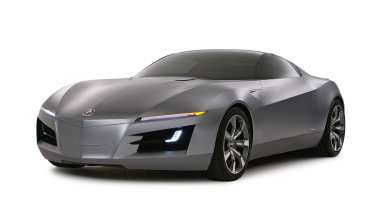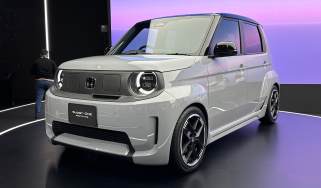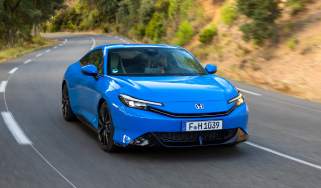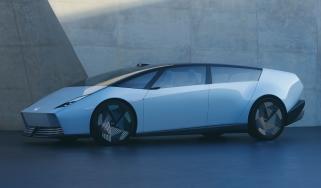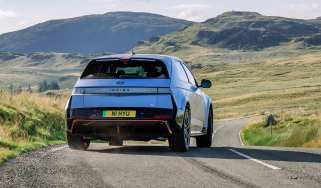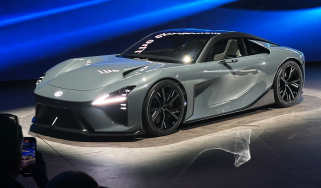Japanese supercar plans: Honda and Lexus lead the new wave
Next NSX and LF-A super-coupe head Japanese sports car revival
After years of quietly ignoring the sector, the Japanese have once again trained their sights on the top-end sports car market. Over the next few years we‘ll see a wealth of high-performance machinery emerge from the major Japanese makers, along with the re-emergence of several famous badges from the past (NSX, Supra, Skyline) and more hardcore versions of some of the few existing Japanese performance cars, such as the Nissan 350Z and Mitsubishi Evo.
At the forefront, certainly in terms of prestige, are a pair of V10-engined super-coupes in the form of the Lexus LF-A and an all-new (and conceptually completely different) Honda NSX. Production versions of both cars are expected to appear at the Tokyo motor show in late October.
The Lexus LF-A is still being touted as just a concept car, but it has clearly been subject to development work since it first appeared at the Detroit motor show at the start of 2005. The version that was unveiled at this year’s Detroit show was the most finished-looking interpretation of the LF-A to date, complete with production-standard interior fittings, cooling fans behind the radiator vents in the tail, excellent shut-lines, ‘real world’ light clusters and other details you’d expect to see on a road car but that aren’t really necessary on a mere concept.
Furthermore, Lexus folk are happy to confirm that the ‘concept’ car has a V10 powerplant with in excess of 500bhp, and that it’s capable of 200mph. This suggests that the company is aiming to take the fight to the likes of the Ferrari 599 GTB and Aston Martin DB9. But it will also be up against a home-grown rival: the Honda NSX.
For the moment Honda’s concept car is being referred to as the Acura ASCC – Acura being Honda’s upmarket brand in the US, ASCC shorthand for Advanced Sports Car Concept – but when it goes into production in 2009 it’s expected to get the NSX name.
However, it’s not an NSX in the mould of the mid-engined original. For starters it’s front-engined, has four-wheel drive and is a 2+2 (a sop to the American market). But, like its forebear, the new NSX will be a technological showcase for Honda, employing lightweight aluminium, advanced construction techniques and a high-tech V10 engine. While Honda is happy enough to confirm the existence of the car itself, it’s revealing nothing about the engine’s capacity or power output.
The basis for the NSX’s four-wheel-drive system has already been seen in last year’s new Legend. Called Super Handling All-Wheel Drive, the electronically controlled system is substantially rear-biased until you find yourself in a tractionally challenged situation. It works well enough in the Legend and further developed for the NSX should sharpen the handling without being intrusive.
Honda is determined that the new NSX should sell in much larger numbers than the original, with which it’s rumoured that the company lost considerable sums on each car sold. Word springing from Detroit, where the ASCC concept was launched, pitches the NSX into the ring with the Jaguar XKR and Porsche 911 thanks to a circa-£60,000 price-tag.
Extra Info
But we’ve seen a wave of new Japanese contenders before, and most have disappeared with a whimper, having barely rippled the surface of the sports car market.
At the Chicago motor show in February 1989, Honda unveiled its NSX supercar, Nissan showed the new twin-turbo 300ZX and Mazda’s MX-5 shook the world; four years later Toyota launched the 320bhp Supra Turbo. Each one was well received by the press and had significant impact within the industry (indeed, it’s fair to say the NSX single-handedly forced Ferrari to improve reliability and driveablity), but only the Mazda – the cheapest of all the cars – sold in any great numbers, and in 2007 it’s the only car that has survived true to its original concept.
The Honda is perhaps the best example of the UK’s blind-spot towards premium Japanese sports cars. The NSX was – and remains – a fabulous car, miles better built than contemporary Ferraris, more modern and usable than Porsche's 964/993 911s. Yet even in its best-selling period, just after its launch, Honda UK shifted no more than 70 NSXs a year.
Can the new generation overcome old prejudices? Well, that’s up to you…

